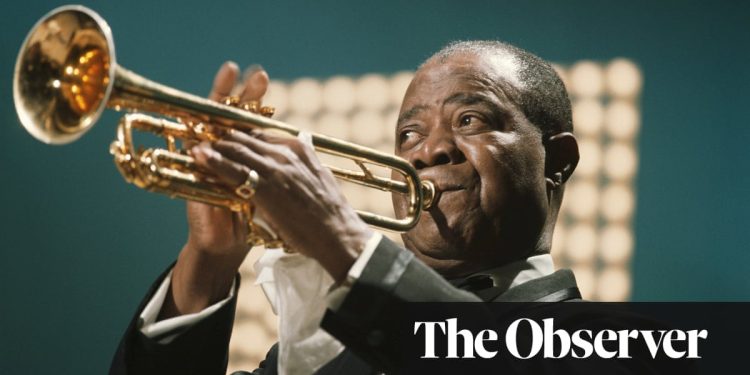He was one of the most influential figures in the history of jazz, famous for tubes such as What A Wonderful World, appearing in Hollywood films and working with Bing Crosby stars in Ella Fitzgerald.
The childhood of Louis Armstrong, however, was a world far from his life later – he grew up in serious poverty in a district plagued by crime and violence. New evidence has now shed new light on the musician’s beginnings, including revelations that his mother and sister have faced arrests for prostitution.
Armstrong was born in 1901 in New Orleans. In 1912, he was arrested and sent to the home of Waif Colored where, under the music teacher Peter Davis, he learned to play the Cornet and dreamed of becoming a professional musician. In 1922, he joined the group of Cornetttiste King Oliver in Chicago and, in 1925, he made records under his own name. In the 1960s, his recordings – notably his version of the song title of the musical Hello, Dolly! – It was so popular that they dropped the Beatles from the top of the charts at the top of Beatlemania.
Armstrong spoke with worship his mother and sister, eternally grateful for their encouragement. Although biographers wrote on his difficult childhood, there was no evidence – although a lot of speculation – that they had to turn to prostitution to join both ends. Now, police reports and interviews have been revealed revealing that his mother, Mayann, and his sister, Beatrice, were arrested many times, spending days in prison.
The revelations will be published in a new book by Ricky Riccardi, director of research collections for Louis Armstrong House Museum in New York and a winner of a Grammy Award for his work on Armstrong recordings.
Stomp, let’s go: the first years of Louis Armstrongwhich is published by Oxford University Press this month in the United States, and in May in the United Kingdom, is based on bands, manuscripts and unpublished letters, including interviews with Armstrong sister in End of life, an unfinished autobiography of the second wife of Armstrong, Lil Hardin ,, and the non -edited manuscript of Armstrong for his autobiography Satchmo: My life in New Orleans.
Riccardi said to Observer: “Louis spoke of prostitution in his neighborhood, but he never went to his mother to do so and be arrested. Now I have the proof in black and white. The incredible part is that all the police files were downloaded to ancestry.com (the family history website) about a year and a half. They seem to have been detained by the New Orleans public library.
In a police report from 1914, Armstrong’s mother faced a fine of $ 2.50 or 30 days in the detention chamber, with the “Occupation – Prostitute” note. The officer recorded: “Fine unpaid”.
Riccardi said that Armstrong was the ultimate story of rags to the rich – a “child who grew up eating food picked from bins”, whose father left almost immediately after the birth of his sister and who lived Among violent criminals in a New Orleans district which was so dangerous that it was known as “the battlefield”. He added: “Louis always treated people with respect and he was nice. He loved people and gave his mother all the merit of having taught him to behave. But, at the same time, she would disappear for a month at a time. »»
Riccardi said about Armstrong’s sister: “I found her arrest files for prostitution and a newspaper article who said that she had shot a man in an apartment known for her prostitution. In one way or another, she did not leave for a long time, but she was arrested for this. »»
Riccardi was also struck in 1916, arresting papers for Armstrong himself, to “stroll”: “This vague term often gave the police an excuse to gather blacks to have apparently just existing, but it was sometimes applied to the world of prostitution.
“It ended with that he was stabbed in the shoulder with a prostitute. I found a cassette where he talked about it and showed his scar, and I talked about his mother who almost killed the prostitute when she discovered it. »»
After promoting the newsletter
Armstrong declared in the band, a conversation recorded in private with his friend and record producer George Avakian in 1953 which was discovered in the Avakian collection at the public library of New York in 2023: “I do not remember how many times I went to prison. It was a common thing at that time. »»
Riccardi also found police reports concerning other characters from Armstrong’s childhood, showing that these were violent criminals in a “fairly scary environment”. They include “Black Benny”, which was a paternal figure of Armstrong, but was accused of violence against women and throwing a brick on a man, fracturing his skull.
In other unpublished interviews, Armstrong remembers having dodged bullets: “They say that the Lord takes care of fools – he is sure to take care of me. These balls whistle and I just blow the blues.
“But I was never injured … If someone starts to shoot, I don’t see how I was not touched.”
Riccardi said: “The fact that he survived was a kind of miracle.”
Armstrong never stopped performing until his death in 1971. Riccardi thinks that he was motivated by his memories of poverty: “He was hungry once, he had been poor – and he was not going resume thus. He pushed himself to the edge, performing every night. »»


